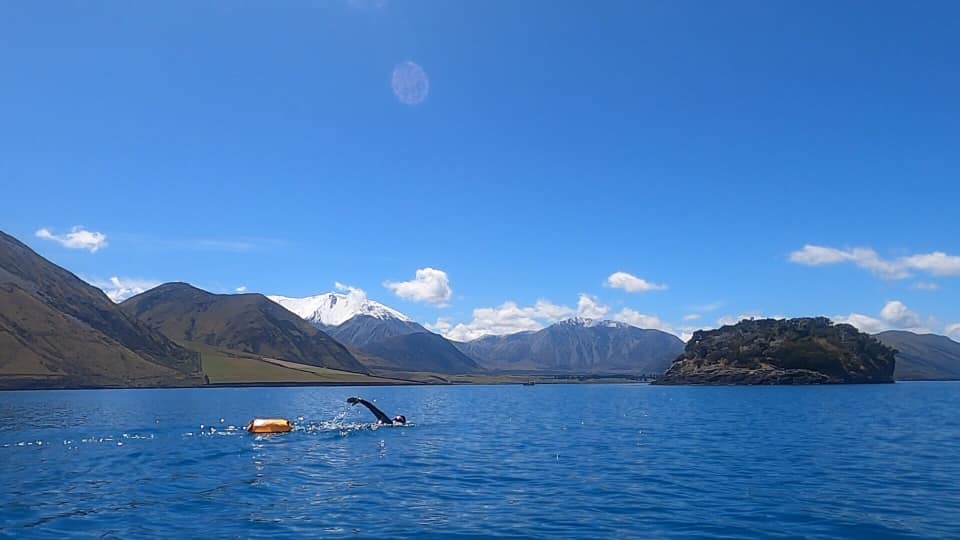
The frost was still on the ground when I stepped out of the van at the far end of glacial Lake Coleridge. A few days after Christmas 2020, one of the higher secluded mountain lakes in New Zealand awaited me. A distance of 16km, this wouldn’t be the longest swim I’d ever attempt, but it would become one of the more important marathon swims for my personal headspace.
I’d been in an introspective and reflective mood for some time at this point because I was putting the finishing touches on the rough draft of my rookie attempt at writing a book. I’d long had writing an adventure memoir on my life to-do list, however, for various reasons, and it had gone on the back burner on several occasions. After completing the biggest marathon swimming challenge of my life in February 2020 – the unprecedented swim of the Mighty Clutha River, a distance of 256km from Wanaka to the Pacific over four and a half days, I felt I had a logical conclusion to writing a book.
With that challenge behind me, I set my sights on other beautiful swimming environments, and Lake Coleridge was near the top of the list. I’d swam in Lake Coleridge before. Two years previously, I’d devised a self-made adventure triathlon week, and on one of the days, and I swam approximately 10km in Lake Coleridge. I was unable to secure kayak support, so I swam an out and back marathon swim, hugging the perimeter of the west side of the lake for about 5km, never venturing more than about 25 meters from the shoreline.
This time, I’d secured kayak support, and I was about to attempt the 16km crossing of the frigid yet stunningly beautiful ice blue lake. Nestled between a mountain valley in northern Canterbury, the isolated outdoor adventure paradise was a surreal place for a marathon wild swim. Hilary, my kayaker, I had only met in person for the first time as we pulled up to the lake. We’d met via a Facebook post in which I’d asked for kayak support for my swim attempts of Lake Coleridge and my later attempt of swimming the 26km Lake Tekapo later in the summer. She volunteered for both.
Dipping my feet into the frigid waters, it was evident that my choice to wear neoprene booties, along with my wetsuit, was the right one. A few strokes into the swim, it was then obvious that I’d need my neoprene gloves as well. The summer was just beginning in New Zealand. While lake temperatures on South Island never reach the balmy temperatures of Australian beaches, the elevated glacial lake, still being fed by snowmelt run-off, was never going to allow a ‘skins’ swim, at least not for me.
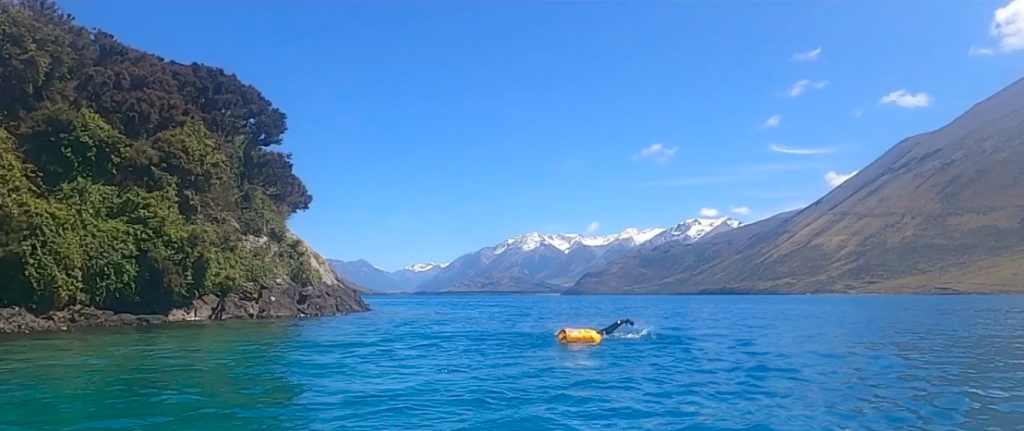
Being Canadian and having grown up in Newfoundland, where the lakes and even the harbour are frozen several months of the year, cold water never bothered me that much. I was more than capable of the 1500m swim distance of most triathlons in such temperatures, and at one point, I’d even swam around an iceberg, a distance of five or six hundred meters. However, a sixteen-kilometre swim was different. There was no chance I could complete the estimated four hours without the modest cold protection of my neoprene wetsuit, gloves, hat and booties. Hypothermia would certainly set in long before I’d make it even a third of the way.
There’s often controversy and internet comment jabs in the marathon swimming community over the use of wetsuits. They offer an undeniable buoyancy advantage, leading to shaving approximately 3-5 seconds off every hundred meters. In colder water, they allow the swimmer to stay in the water longer. For the purposes of competition or record-setting attempts, official marathon swimming organisations rightly do not recognise the swims that are completed in wetsuits.
I was in a different position, one I’d always seem to find myself in throughout my life – never quite fitting into the box. When I began training for triathlons in 1989, the sport was still relatively new, and the people who competed in them were clearly a different breed of folks. It seemed to be an ‘out there’ sport that I enjoyed much more than the conventional things like hockey, basketball and baseball.
My first long-distance swims were the swim legs of triathlons in Atlantic Canada, where the water is cold, and it is standard practice for triathletes to wear wetsuits. As I also branched out into marathon swimming, I often started my long-distance outdoor swims with no wetsuit. The cold was not generally a problem for me, but I ran into the unsolvable problem of the sun. Being a freckled redhead from Newfoundland, my sun repelling genetics are about as poor as can possibly be. Even with layers of sunscreen, there was no possible way I could swim with my back exposed to the sun for hours at a time. As time went on and full sleeve lycra triathlon suits were developed, I experimented with them. Unfortunately, they caused severe underarm chaffing, no matter which brand of suit and no matter how much lube I used. For some reason, full sleeve wetsuits don’t chafe, at least not with me. When I moved to Australia for 15 years and then for the last three years in New Zealand, where the sun is infinitely stronger than in Newfoundland, I couldn’t be a marathon swimmer if I didn’t cover myself up.
Then I asked myself why I wanted to marathon swim. If I were to wear a wetsuit, I couldn’t make any claims if I were to set a record. It didn’t take me long to realise that while I’m a decent swimmer, I have no chance of setting records on the recognised courses. While I can’t explain fully why I still push myself to do long-distance triathlons and marathon swimming as a 45-year-old amateur, I do find joy, peace and a flow state, particularly in the water. I’m happy being an unrecognised ‘wild’ swimmer, not following the rules of any federations, marathon swimming for no purpose other than personal fulfilment. I just ignore the internet comments over wetsuits in the swimming community that often seem as toxic as discussing American politics. I also didn’t care if my swims were ‘recognised’ by an official governing body.
I found that I also didn’t fit into the typical marathon swimming box because I was choosing courses that few, if any, had ever done. After moving to New Zealand, I developed a passion for river swimming, which is almost unheard of in the sports world, and few marathon swimmers venture into the rivers.
In some circles, river swimming is ridiculed as ‘downhill swimming’ and that they ‘don’t count.’ Having now completed many rivers swims, I realised that river swimming – despite obviously going faster than in still water-is actually more challenging work. As you do your stroke, your arm is going against the oncoming current. Depending on the river, there are many twists and turns, rapids, obstacles to avoid and other hazards. You, therefore, have to sprint at completely random times, as opposed to keeping a steady pace to get across a lake or a stretch of ocean. Because there are so many sprints, rapids to navigate and the speed at which you travel, I simply find river swimming to be so much fun; I don’t care if it upsets a few people who feel compelled to make toxic internet comments.
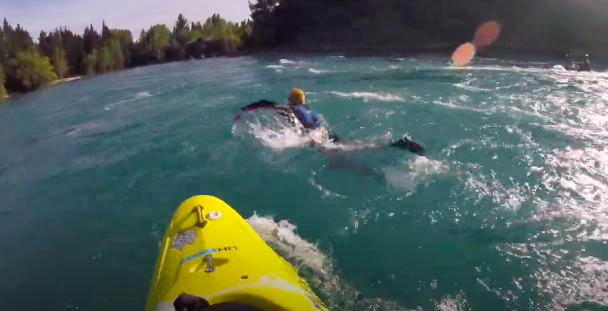
I also found that for many rivers, wearing a wetsuit is necessary as a modest form of protection against the possibility of collisions. Wearing booties was a good idea for the times when you might need to stand up. I also found that for the long-distance swims on sunny days, I needed the booties because, on one occasion, the soles of my feet became so sunburned after a six-hour swim, I could barely walk for a week!
So a wetsuit wearing river swimmer doesn’t fit into the mould of a typical marathon swimmer. Especially since I now often add on a full-day bike ride followed by a full day run to create a backcountry adventure triathlon. I didn’t know it as I dove into the frigid waters of Lake Coleridge, but I was attempting the first known crossing of the lake. I had simply assumed that someone must have done it before when I came up with the idea. All that really mattered to me was swimming in a beautiful environment, and I was about to enjoy a beautiful day, doing what I love to do more than anything.
As I recovered from the initial shock of the glacial water – still overwhelming at first, despite the neoprene – I found my usual rhythm and settled into what I refer to as my ‘flow state.’ Many people find there ‘flow’ doing various things. Some find it running, some with art, some with yoga, some with cooking, writing, working on a car, gardening, or countless other creative or physical outlets. I’m fortunate to find it through several ways, but far and away, swimming in a beautiful environment is where I am most likely to find that space.
The flow state is where the mind can quiet, everything melts away, and you enter the ‘zone.’ As my arms sliced through the mirror-like water, surrounded by snow-capped mountains on a beautiful day, time stopped, and I was exactly where I wanted to be.
I later made a short film of the swim, and I chose the song “Beauty” for the soundtrack of the video clips that I strung together that Hilary had shot from her kayak. It seemed like the most appropriate song I could have chosen. Shaye – a Newfoundland singer, performs the song. The song is about a person who left Newfoundland to travel the world, adventuring in beautiful environments and finding beauty in the toughest places. It seemed like an appropriate reflection of my life, and I had been writing about it for the past several months in my adventure memoir.
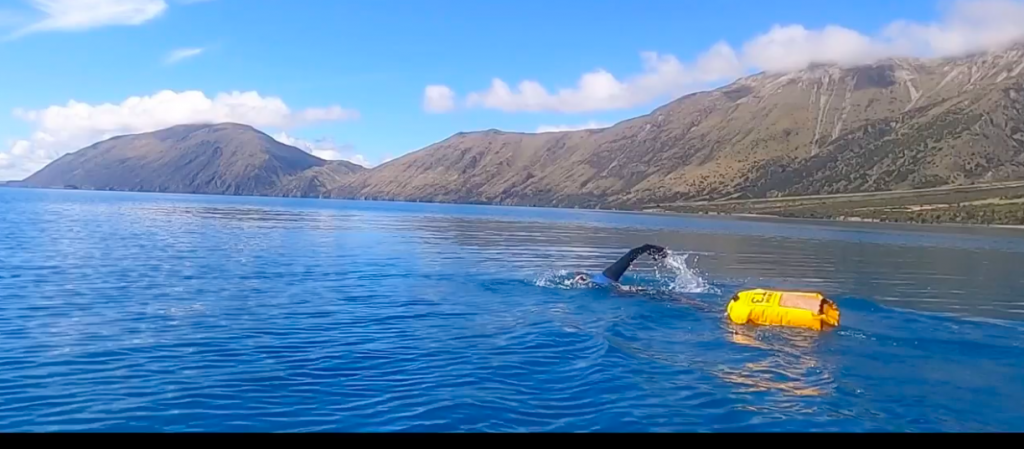
I thought about the song as I swam, sometimes singing it to myself, sometimes reflecting on my life, sometimes wondering why I still swim such long distances at my age when I never had been and never would be the best at what I do. My goals for the sport weren’t even typical. The English Channel wasn’t calling out to me. I wanted to swim in the Kiwi Fiordland, more rivers around the country. I wanted to travel to Scotland to meet with a Scottish swimmer in Stornoway who has swim camping adventures around the remote islands off of the Scottish mainland. After watching my homemade documentary of the Clutha River, an American friend contacted me with a plan to eventually swim the rivers in the canyonland in Utah. Oddly enough, one of my biggest marathon swimming goals is to swim in my hometown down the powerful Humber River, from the town of Deer Lake to the mouth into the Bay of Islands. These were indeed ‘outside the box’ marathon swimming goals.
Reflecting on my goal of returning home someday for that swim and also mentally reviewing my book that was nearing completion, I passed peacefully passed by the mountains, completely oblivious now to the cold water. My mind was now successfully blotting out the fact that my face felt like ice. I thought once again about my journey into triathlon as a teenager and how that time period coincided with my father’s drinking getting entirely out of hand. I’d just completed a chapter of my book describing my first fight with my father as he drunkenly attacked me. At the time, competing in triathlons and marathon swimming not only gave me a sense of joy, but it also gave me a sense of taking back control of my life when I felt that control was threatened by his alcoholism.
Many years later, I came to understand that control is an illusion. I never had control, and neither does anyone else. I thought I could control having a life full of adventure, love, and meeting funny and interesting characters during my nomadic travels and living in five different countries around the world. I made a strong and rigid choice to avoid the common vices that people often fall into when they feel like they are losing or have lost control. I vowed never to become an alcoholic or a drug user. When many of my high school and college friends and acquaintances were heavily using alcohol and drugs at parties, I stayed away. There was no chance I wanted to end up like my dad. As I got older, I also made strong-headed choices to avoid the other vices like gambling, affairs or attempting to control others by gaining power over them, either at work or at home. At the time, making these choices made me feel like I was in control of my life.
A long journey of triathlons, adventures and travelling – ultimately taking up river swimming – led me to realise that control is an illusion and that nobody has it, despite their best efforts to gain it. Nothing makes that more apparent to me than river swimming, where the conditions to be able to complete the swim are completely up to mother nature.
As I passed the small island about a third of the way through the distance of the lake, watching the birds fly about and the snow-capped mountains reflecting their majestic beauty into the water, I realised that this swim was another lesson in not having control. I originally planned to attempt the crossing in late March 2020. The week before I was scheduled to do so – the kayaker availability, my training, and the weather forecast all lining up – New Zealand went into a total lockdown as the covid-19 pandemic spread around the world. By the time lockdown was over, it was too cold to attempt to cross the lake safely, and it would have to wait until the following summer season.
There’s a certain peace and serenity that builds up within you when you accept that you have no control in life. At best, we have influence over outcomes but never control. I’ve noticed that it’s become common for people to say things as they face various forms of adversity, such as, “I cannot control everything, so I will only focus on those things that I can control.” I also used to think that, never at a time more so than when I realised that an inguinal hernia at age one had left me unable to father children. I didn’t realise that until age 33, and I initially thought that by getting myself as healthy as possible, I could control having children. When that didn’t work, my wife and I entered the heart wrenching Australian adoption system. For five years and sinking all of our money into the process, the countries we tried to adopt from closed their programs for various reasons, we were eventually told that we were not eligible to adopt from any country with an adoption agreement with Australia.
Never in my life did I feel so powerless when I realised that I was not going to become a father, despite not drinking, not doing drugs, being fit and healthy, feeling I was a decent person to be a father and nearly bankrupting myself to adopt children. It took a long time and many miles in the water and on the trails to come to terms with it.
As the small beach on the other side of the lake gradually came into view, an unforecasted strong headwind struck, slowing the pace to such an extent that it felt that the mountain I was passing was just not getting behind me. At various times, Hilary later told me that I was effectively on an aquatic treadmill during some of the stronger gusts of wind. But this was New Zealand, in the mountainous backcountry, and there was little hope of ever accurately predicting the weather. Certainly, there was no controlling it.
With the benefit of retrospect and my manuscript of the book now complete and sent to publishers, I see the parallel between writing and publishing a book and marathon swimming or triathlon. I believed I’d scored the perfect conditions – cold aside – to attempt to swim Lake Coleridge. I’d started the swim with mirror-like blue water; the sun was shining. I had a great new friend expertly supporting me from her kayak. Now I was suddenly and unexpectedly fighting the oncoming waves that the Northwesterly wind was picking up, and despite increasing my effort, I was barely going anywhere.
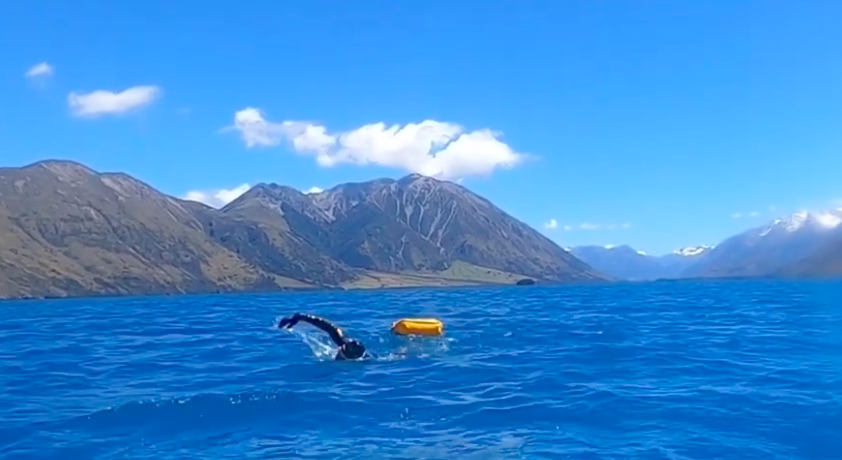
I knew that as a first-time author when I submitted my manuscript to various publishing companies, it would be an unknown road. My manuscript was unsolicited, I’m not a well-known person, and I don’t have tens of thousands of social media followers. It has become a waiting game to see if I could get it traditionally published or if I’d eventually have to try either hybrid or self-publishing. I received my first rejection letter this past week. A university-based publishing company wrote back to me and said that they are now only publishing books appropriate for university purposes and that my book is certainly not that. The editor told me that she continued to read the book despite immediately knowing that it was not an appropriate fit for their company. She told me that it was a well-written book with good humour and passion and believed that another publishing company would accept it.
I’ve come to understand that publishing companies don’t necessarily reject books because they aren’t worthy of publishing. Different companies have specific ideas about which sorts of books that they aim to publish for any given year. It’s another lesson in not having control over outcomes. I poured my heart into writing a book, I believe I did a decent job, and I believe it is worthy of publication. I felt that when I submitted it to the Kiwi branches of larger publishing companies, I thought I had a decent shot at being published because I was the first person to swim the Clutha River. It’s an ‘outside the box’ adventure story. Ultimately, however, I don’t control if a traditional publisher decides to go ahead with it and the waiting game has commenced.
Marathon swimming and long-distance triathlon have taught me patience. However, patience in endurance sport feels different from patience in waiting for an email from a publisher. As I battled the wind in Lake Coleridge, it could be argued that I had some control over the outcome of ultimately finishing the swim because I decided not to give up in the face of nearly overwhelming headwinds. At a snail’s pace, I completed the final third of the swim. My estimated time of four hours was way off, and I’m glad Hilary also seemed to be the patient type. Five and a half hours after I shocked my system in the frigid water, I stumbled up onto the small beach approximately 16km on the other side of the remote mountain lake. It was my longest swim of the 2020 – 2021 summer season so far, and I felt a great sense of accomplishment.

Reflecting on the patience that is necessary for long-distance swimming, it is easier than waiting for a publisher’s email, either rejecting or accepting my book. While swimming, I recognise that I’m not controlling the outcome of the swim, but I can keep swinging my arms and feeling like I’m ‘doing something to influence that outcome that I want. I can’t do that with a publishing company, and I can only wait. The hard work of writing, self-editing, self-editing again, and again, and having an editor do her work afterwards is already finished. No more action can be taken until such time as a publisher responds. It’s frustrating. Last week, I found myself checking my email every hour until mid-week, when I realised what I was doing, and I stopped.
Whether traditional publishers pick my book up or not, if I publish through a hybrid company or self-publish, I also don’t get to control how many sales are made. I’ve briefly read articles online about people claiming to have the answers to make it big as a writer. There are definite strategies that can help in book sales, but often, good books remain unread. No writer or self-described writing coach can control the outcome of book sales.
I’m under no illusions of making it big as a writer, and in the off chance that my book is successful, I’ve learned to compare the process of writing to my marathon swimming and triathlon. Endurance sport and writing are things that bring me joy. I’ll never be the best marathon swimmer or triathlete, though I did reasonably well for a while in the competition despite my genetic ability being comparable to a hippopotamus. I still feel as strong as ever in my self made adventure marathon swims and triathlons, despite not being as fast as I was in my 20’s. While I don’t fully answer why I keep doing it after over thirty years and even writing a book to help me discover my ‘why’, I know that it brings me joy.
When I finally committed to writing a book, I asked myself, “If I knew for a fact that I will not make money by writing this, would I still want to write it?” The answer turned out to be an emphatic, ‘yes!’ Having now completed the book and awaiting responses from publishers is testing that mindset, however after overcoming brief moments of frustration, the answer is still the same.
Much like endurance sport, during the writing process, I had many, ‘what the f@&k am I doing this for?” moments. It was a unique endurance challenge, though, despite a handful of those low moments, I’m glad I persevered and kept going. It’s reconnected me with my creative side that I’d largely neglected in my 30’s and 40’s and I intend to write more books, even if only a half dozen of my friends buy my adventure memoir.
I believe that many untalented endurance athletes will be able to relate to my story, and I hope that with the sub-themes of dealing with an alcoholic parent and infertility, my book may appeal to a broader audience beyond the endurance sports community. Whether or not it reaches beyond my circle isn’t really up to me. Still, like the tools that I’ve built up over the years that led me to be able to be the first person to swim across the majestic Lake Coleridge, I intend to do whatever I can to promote my book when it is finally released in one way or another. I intend to write more books, even if it’s a flop.
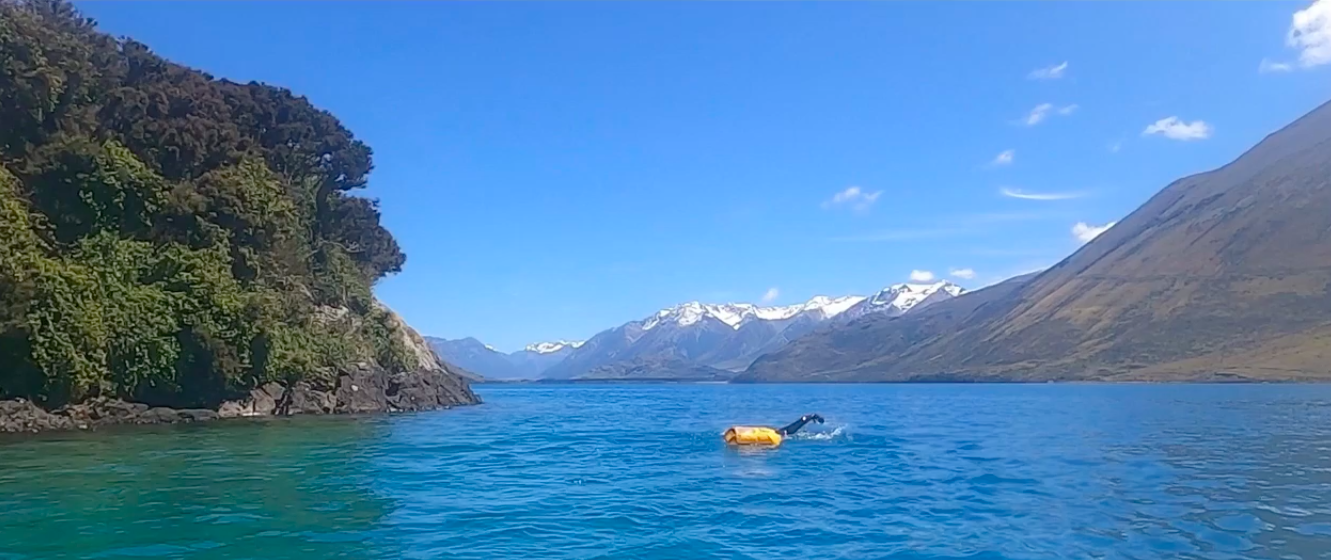
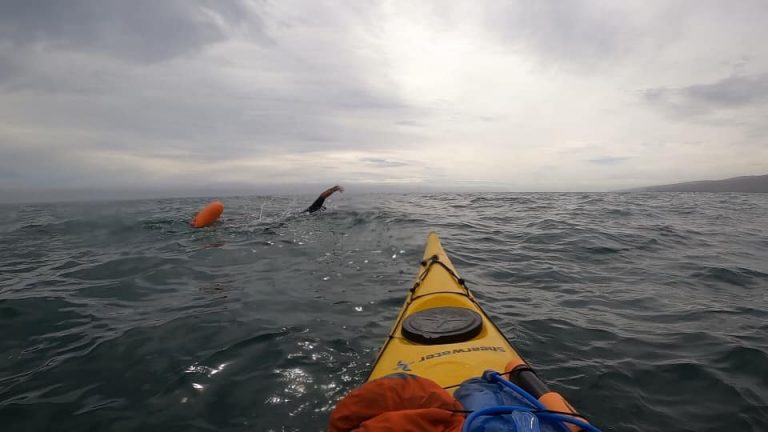
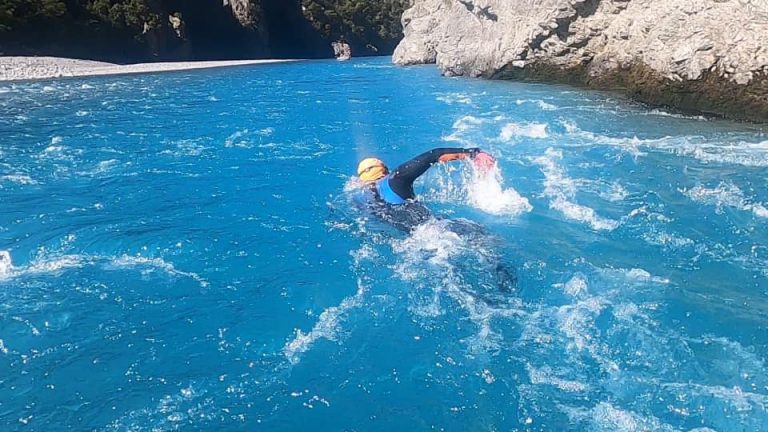
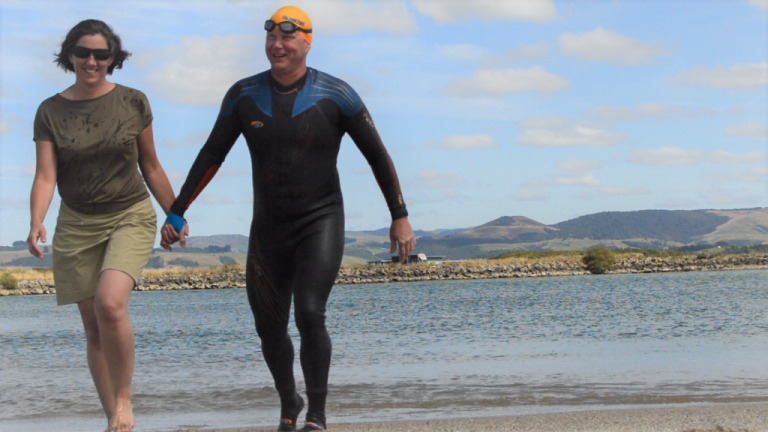
A powerful story from the heart rob.